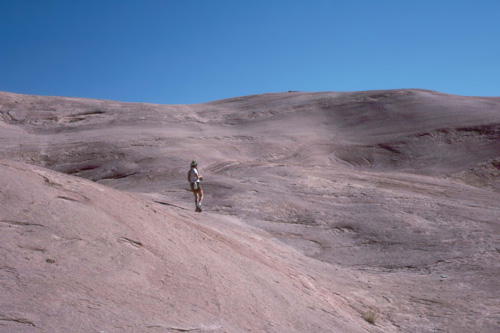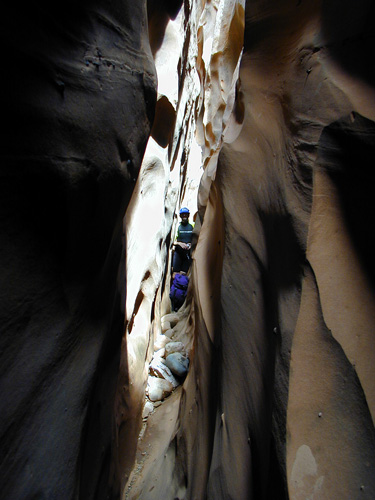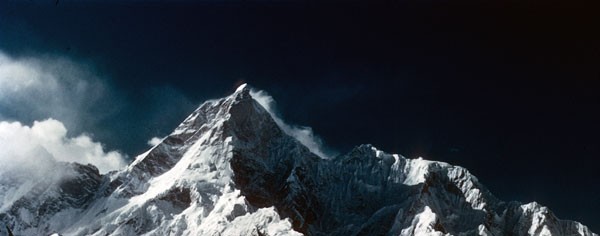Los Alamos Mountaineers
You are here
A New World of Canyon Trips
By 1973, the Mountaineers were starting to discover a new world remote from the mountains -- the canyon country of Arizona and Utah. This includes the Grand Canyon, the Navajo Indian Reservation, Buckskin Gulch and Paria Canyon on BLM land, Canyonlands National Park, the Escalante National Monument, and many other beautiful areas. Over the years, more and more club members have come to enjoy the desert world of broad arid plateaus, narrow slot canyons, and secret cool oases of water. For some members, the desert has come to have a stronger emotional pull than the high mountains themselves.
Bob Cowan, Jim Breedlove, Peter O'Rourke, Norbert Ensslin, and other club members participated in a two-day backpack through the Zion Narrows in October 1973. Over the years this has remained a well-known and popular destination during the dry, cool fall season when the danger of flash floods from thunderstorms is low.
Over the 1973 Thanksgiving break, Merle Wheeler introduced the Mountaineers to their first cross-country, off-trail, rough-and-tumble canyon trip to the Navajo Indian Reservation. This was a backpack into Navajo Canyon from near Tsai Skizzi Rock, requiring the use of ropes and Anazasi toehold routes to find a way into and out of the canyon. The trip provided many opportunities to explore dark narrow slots, hidden arches, and high sandstone domes. Merle had just come to Los Alamos from Tucson, where he had been an active member of a small group of canyon explorers at the University of Arizona. Merle was also a strong rock climber and had done a number of very hard first ascents on Beeline Dome and Rockfellow Dome in the Cochise Stronghold. He had no fear of boldly sliding, jumping, or falling into the most impossible-looking slots, mudholes, or other canyon obstacles.
Fig. 1. Merle Wheeler enjoying one of his favorite activities,
"dome running" near Navajo Canyon (N. Ensslin photo, 1973).
Many of the club's canyon trips have tried to emulate Merle Wheeler's enthusiasm for slot canyons. Some trips, like upper Kaibito Creek and the Black Hole in White Canyon, have involved getting into deep, dark, wet slots. These trips required carrying waterproof packs, ropes, and equipment for rappelling, jumaring, or setting anchors. The reward for all of this effort is an almost other-worldly experience, totally removed from the ordinary. Norbert Ensslin remembers that "When you jump into a dark pool of water in a deep slot and sink in over your head, suspended in total cold darkness for a moment, the rest of the world seems very far away!" Even on a hot summer day, some of the deepest slot canyons are so cold that wet suits or dry suits are needed to get through without risking hypothermia. When Jan Studebaker and Norbert Ensslin reached the exit of a slot canyon near Navajo Mountain, they were so cold that they just threw their packs into the last plunge pool, jumped in, and quickly swam across to lie down on a small sunny beach. While they were trying to get warm, they heard a loud, continuous knocking noise. Norbert's legs were shaking uncontrollably and one of his knees was knocking against a small rock!
Fig. 2. Kurt Short playing the slots in a narrow canyon near Navajo Mountain.
He's wearing an upper body wet suit, and pushing his pack along ahead of him
( Mike Sullivan photo, May 2005).
Ever since 1973, the Mountaineers have enjoyed many Spring and Fall canyon trips between the summer climbing and winter skiing seasons. Merle Wheeler led other Navajo Country trips to the area around Navajo Mountain through at least 1978. Other early club canyon trips include a trip to Dark Canyon led by Hank Blackwell in 1979. Bob Cowan recalls that the group included Dennis Brandt, Dave and Faye Brown, Roland Pettitt, John Sarracino, and Bill Priedhorsky. They entered Dark Canyon from the mesa north of Natural Bridges National Monument, and climbed out via the Spanish (or Golden?) Staircase. Bob Cowan also joined a May 1987 trip to Dark Canyon led by Bill Priedhorsky, using the Spanish (or Golden?) Staircase in both directions. Hank Blackwell and John Sarracino also led additional canyon trips in 1980, 1981, and 1982.
In 1995, some club members saw an article in the June issue of Outside Magazine, by David Roberts and Jon Krakauer, that described a trip to an unidentified "Mystery Canyon" near Navajo Mountain. The authors did not say where this canyon was, but described how they had found the entrance by climbing a set of Indian toeholds near Surprise Valley. This article appealed not only to the Mountaineers' sense of adventure, but also to their enthusiasm for deciphering secret information. They carefully analyzed every detail in the article and realized that the toehold route might be one that Merle Wheeler and Hank Blackwell had used some years earlier on a trip that circled the north side of Navajo Mountain. So in May 1997, the club organized a trip to this area. Sure enough, they found the "Mystery Canyon" right where they thought it would be!
Trips to Navajo Country, Zion, Escalante, and the Maze have now become a regular and well-loved part of the club's annual schedule, with many of these trips led by Bill Priedhorsky. The canyon trips provide a way to extend the summer by climbing into the warmest places available within a day's drive of Los Alamos. The relatively small canyons in the Navajo and Escalante areas have actually been more popular than the more dramatic scenery in the Grand Canyon, perhaps because they provide a more intimate experience.
The Mountaineers' canyon trips have led to the creation of new club traditions, like having Thanksgiving dinners in the canyons, with frozen turkey, seal-a-meal mashed potatoes, gravy, and dressing, and carefully-transported pumpkin pies. There were many jokes about making the turkey walk in with the party, but so far as we know it never actually happened.
Theme by Danetsoft and Danang Probo Sayekti inspired by Maksimer
